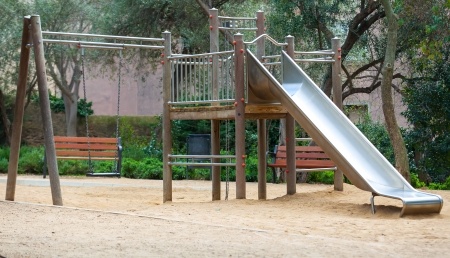Too Hot To Handle - Big Risk For Children Using Playground Equipment
July 10, 2015 | Category: Child Injuries, Defective Products | ShareParks and playgrounds are popular destinations for children, but playground equipment may be "Too Hot To Handle." Playgrounds can be deceptively hotter than one realizes. When the outdoor air temperature reaches 90  degrees, which happens virtually every day during Florida's school summer vacation, the equipment can heat up to a dangerous 120 to 150 degrees. Touching these surfaces may cause first- or second-degree burns, according to the Tucson, Arizona, Tucson News Now.
degrees, which happens virtually every day during Florida's school summer vacation, the equipment can heat up to a dangerous 120 to 150 degrees. Touching these surfaces may cause first- or second-degree burns, according to the Tucson, Arizona, Tucson News Now.
Last summer, July 2014, KATU News in Portland, Oregon conducted a thermal imaging test to measure the temperatures of playground equipment at a local public park. Using a high-tech camera supplied by a manufacturer who makes surveillance technology for the military, they found that although the playground equipment in the park was made from modern plastic and other materials which were designed keeping heat-safety in mind, the results showed:
- Pavement - 106 degrees
- Mulch - 145 degrees
- Plastic slide - 130+ degrees (98 degrees in the shade)
- Metal ladder - 100 degrees
- Metal handle - 94 degrees
- Plastic tic-tac-toe board - 95 degrees
- Metal bridge - 126 degrees
- Wooden bench - 140 degrees (88 degrees in the shade)
- Metal water fountain - 113 degrees
Worcester Polytechnic Institute in Massachusetts reported in 2011 that metal playground equipment has long been known to cause burns, and playground manufacturers have almost entirely switched to using recycled plastic and rubber products. Metal, being an excellent conductor of heat, it is able to cause burns quickly. When using plastic and rubber, which are insulators and do not transfer heat as easily as metal, in direct sunlight, these materials can also burn children when they reach high temperatures. Whether playground equipment is plastic or metal, if it is sitting in the sun on an 80-degree day, it can cause first-degree burns in approximately 3 seconds.
In addition to being burned from the equipment itself, children may be burned by rubber mats, artificial turf and other playground surfacing. A parents' group in New York City says that this surface can absorb heat topping out at over 160 degrees. They further report that when the surface is 142 degrees, it is the same temperature as a cup of hot coffee, according to an ABC News report.
Jennifer King, an Idaho pediatrician said, "Skin can burn starting at 111 degrees. It definitely can cause what is known as a contact burn, where coming in contact with the hot surface can cause superficial burns but also could cause keep burns in kids."
The CPSC (Consumer Product Safety Commission) has important information on their CPSC Fact Sheet on who is most at risk, how to keep children from being burned at playgrounds, and what to do when a child is burned:
Who is most at risk?
A child of any age can be burned by a hot surface; however, children 2 years old and younger are most at risk for two reasons:
- A young child’s skin is more susceptible to burning because it is thinner and more delicate.
- Young children have not yet learned to react by removing themselves from the hot surface. Unlike the reflex that happens when a child touches a very hot surface with his/her hand, a young child who is sitting or standing on the hot surface may scream from the pain of burning, but he/she may not know to move from the location that is causing the burning.
How can you keep your children from being burned at the playground?
- Parents should look for parks that have lots of shade.
- Try to avoid playgrounds during peak afternoon hours.
- Parents should do a touch test on playground equipment before they let their kids play on them.
- Children should keep their shoes on while playing.
What should you do if a child is burned on playground equipment?
If your child is injured on the playground, first seek medical attention, if necessary.
Then:
- Call the park owner or operator, which is often local parks and recreation departments or school systems and notify them of the injury.
- Report the incident to CPSC by calling 800.638.2772 or logging on to SaferProducts.gov.
- Call the manufacturer, if known, and notify them of the injury.
"Parents and their children should expect to be protected when they are using playground equipment. If children are injured by such issues as substandard, or no, maintenance, faulty assembly and/or construction, and lack of warning signs of dangers associated with the equipment, then they need to contact a personal injury attorney to review their rights under Florida's laws," said Attorney Randall Spivey of Spivey Law Firm, Personal Injury Attorneys, P.A.
Fort Myers Child Injury Attorney, Randall L. Spivey is a Board Certified Trial Attorney – the highest recognition for competence bestowed by the Florida Bar and a distinction earned by just one (1%) percent of Florida attorneys. He has handled over 2,000 personal injury and wrongful death cases throughout Florida. For a free and confidential consultation to discuss your legal rights, contact the Spivey Law Firm, Personal Injury Attorneys, P.A., in Lee County at 239.337.7483 or toll free at 1.888.477.4839,or by email to Randall@SpiveyLaw.com. Visit SpiveyLaw.com for more information. You can contact Spivey Law Firm, Personal Injury Attorneys, P.A.in Charlotte County at 941.764.7748 and in Collier County 239.793.7748.

